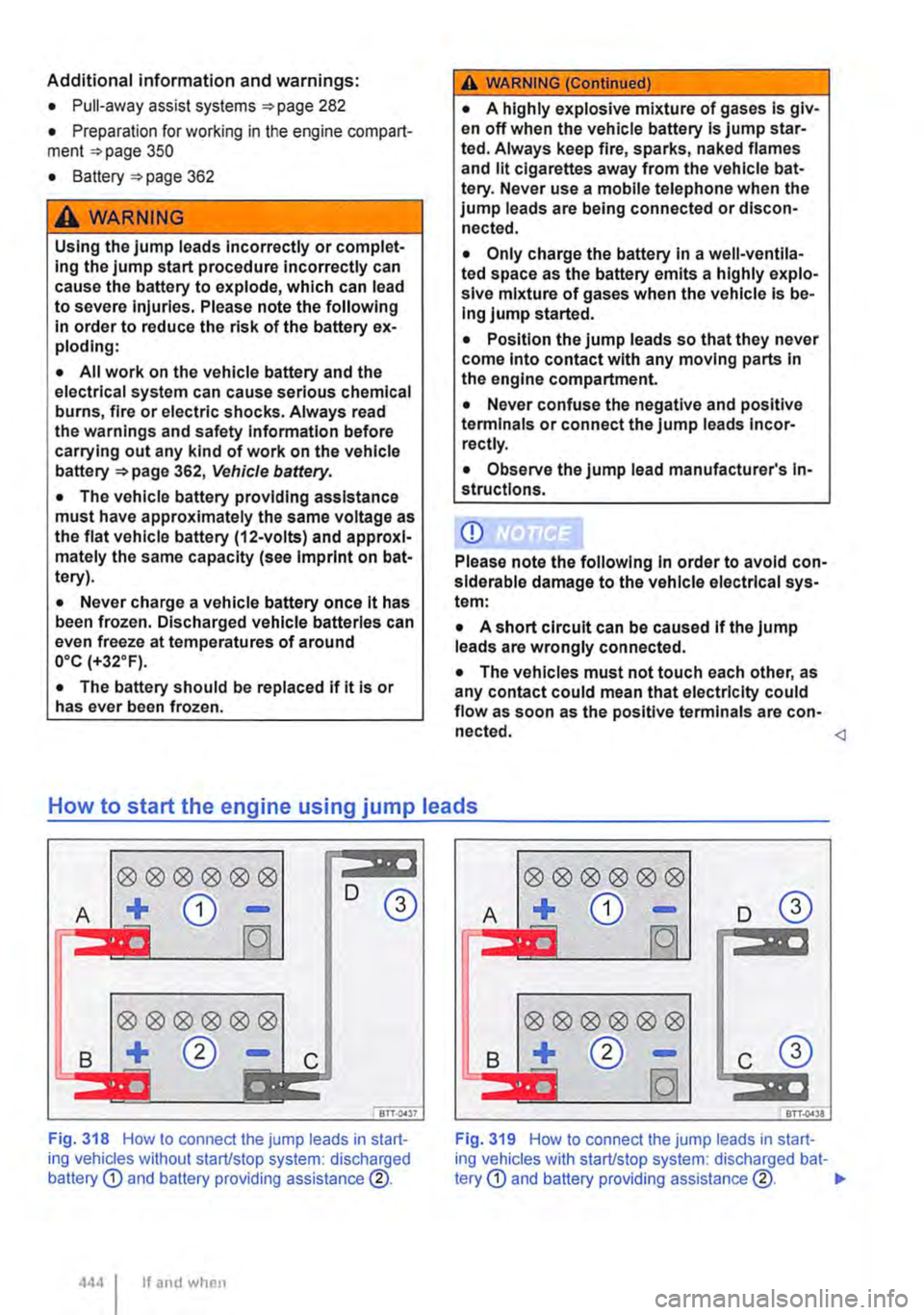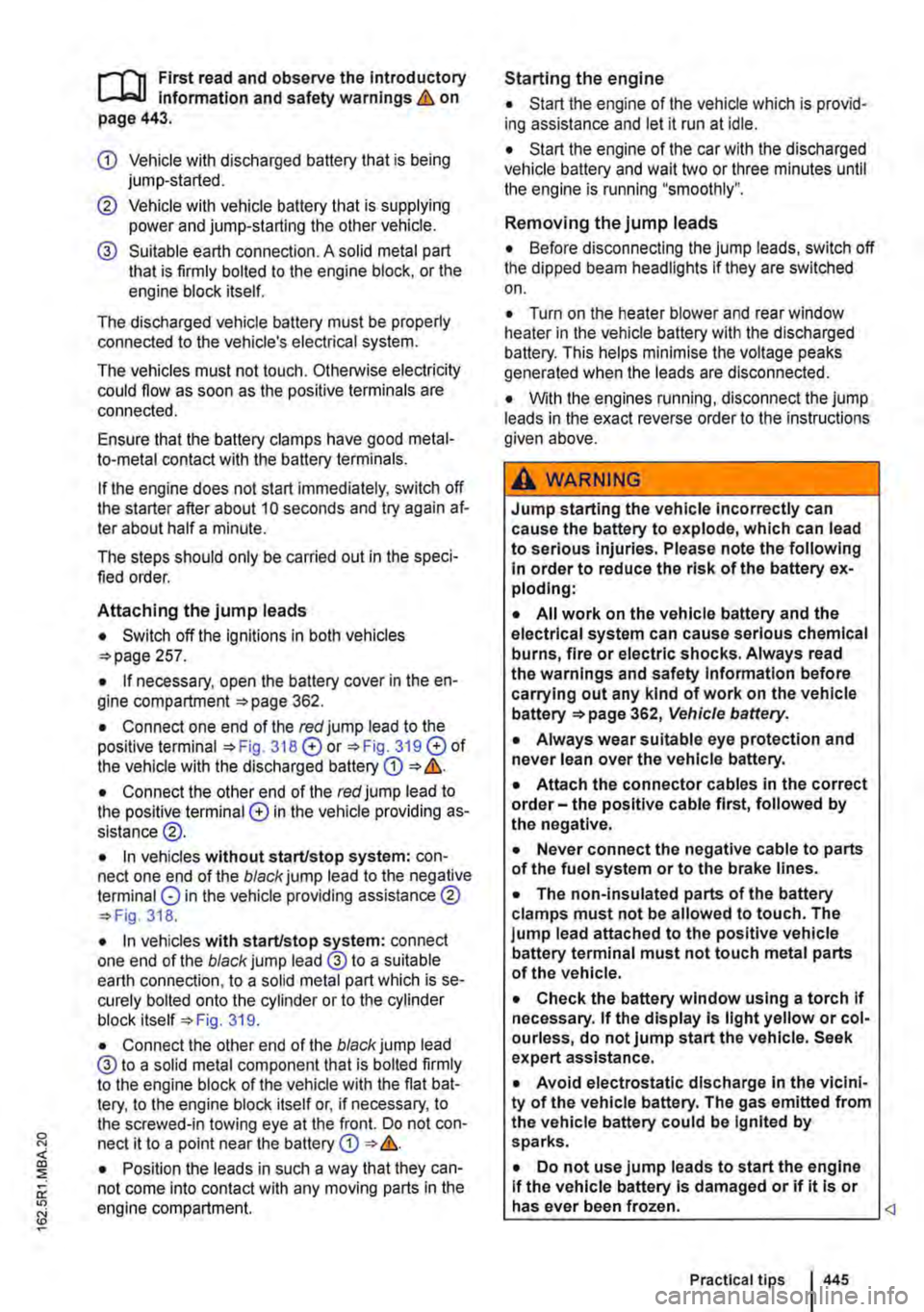jump start terminals VOLKSWAGEN TRANSPORTER 2011 Owners Manual
[x] Cancel search | Manufacturer: VOLKSWAGEN, Model Year: 2011, Model line: TRANSPORTER, Model: VOLKSWAGEN TRANSPORTER 2011Pages: 486, PDF Size: 69.28 MB
Page 444 of 486

Additional information and warnings:
• Pull-away assist systems 282
• Preparation for working in the engine compart-ment 350
• Battery 362
A WARNING
Using the jump leads Incorrectly or complet-ing the jump start procedure incorrectly can cause the battery to explode, which can lead to severe Injuries. Please note the following In order to reduce the risk of the battery ex-ploding:
• All work on the vehicle battery and the electrical system can cause serious chemical burns, fire or electric shocks. Always read the warnings and safety Information before carrying out any kind of work on the vehicle battery 362, Vehicle battery.
• The vehicle battery providing assistance must have approximately the same voltage as the flat vehicle battery (12-volts) and approxi-mately the same capacity (see Imprint on bat-tery).
• Never charge a vehicle battery once it has been frozen. Discharged vehicle batteries can even freeze at temperatures of around o•c (+32"F).
• The battery should be replaced if it is or has ever been frozen.
A WARNING (Continued)
• A highly explosive mixture of gases Is giv-en off when the vehicle battery Is jump star-ted. Always keep fire, sparks, naked flames and lit cigarettes away from the vehicle bat-tery. Never use a mobile telephone when the jump leads are being connected or discon-nected.
• Only charge the battery in a well-ventila-ted space as the battery emits a highly explo-sive mixture of gases when the vehicle Is be-Ing jump started.
• Position the jump leads so that they never come Into contact with any moving parts In the engine compartment.
• Never confuse the negative and positive terminals or connect the jump leads Incor-rectly.
• Observe the jump lead manufacturer's In-structions.
CD
Please note the following In order to avoid con-siderable damage to the vehicle electrical sys-tem:
• A short circuit can be caused If the jump leads are wrongly connected.
• The vehicles must not touch each other, as any contact could mean that electricity could flow as soon as the positive terminals are con-nected.
00®00® :liOIIr 11
D
A + CD -®
fOl
0®®®®®
B + 0 -c 11'"1111
! 8TT.QA37
Fig. 318 How to connect the jump leads in start-ing vehicles without start/stop system: discharged battery
B c
Fig. 319 How to connect the jump leads in start-ing vehicles with start/stop system: discharged bat-tery
Page 445 of 486

r'l11 First read and observe the Introductory L-J,:.,U Information and safety warnings & on page 443.
CD Vehicle with discharged battery that is being jump-started.
@ Vehicle with vehicle battery that is supplying power and jump-starting the other vehicle.
@ Suitable earth connection. A solid metal part that is firmly bolted to the engine block, or the engine block itself.
The discharged vehicle battery must be properly connected to the vehicle's electrical system.
The vehicles must not touch. Otherwise electricity could flow as soon as the positive terminals are connected.
Ensure that the battery clamps have good metal-to-metal contact with the battery terminals.
If the engine does not start immediately, switch off the starter after about 10 seconds and try again af-ter about half a minute.
The steps should only be carried out in the speci-fied order.
Attaching the jump leads
• Switch off the ignitions In both vehicles 257.
• If necessary, open the battery cover in the en-gine compartment 362.
• Connect one end of the red jump lead to the positive terminal 318 E) or 319 E) of the vehicle with the discharged battery CD &.
• Connect the other end of the red jump lead to the positive terminal E) In the vehicle providing as-sistance@.
• In vehicles without start/stop system: con-nect one end of the black jump lead to the negative terminal 0 in the vehicle providing assistance @ 318.
• In vehicles with start/stop system: connect one end of the black jump lead @to a suitable earth connection, to a solid metal part which is se-curely bolted onto the cylinder or to the cylinder block itself =:-Fig. 319.
• Connect the other end of the black jump lead @ to a solid metal component that is bolted firmly to the engine block of the vehicle with the flat bat-tery, to the engine block itself or, if necessary, to the screwed-in towing eye at the front. Do not con-nect it to a point near the battery CD &.
• Position the leads in such a way that they can-not come into contact with any moving parts in the engine compartment.
Starting the engine
• Start the engine of the vehicle which is provid-ing assistance and let it run at idle.
• Start the engine of the car with the discharged vehicle battery and wait two or three minutes until the engine is running "smoothly".
Removing the jump leads
• Before disconnecting the jump leads, switch off the dipped beam headlights If they are switched on.
• Turn on the heater blower and rear window heater in the vehicle battery with the discharged battery. This helps minimise the voltage peaks generated when the leads are disconnected.
• With the engines running, disconnect the jump leads in the exact reverse order to the instructions given above.
A WARNING
Jump starting the vehicle Incorrectly can cause the battery to explode, which can lead to serious injuries. Please note the following In order to reduce the risk of the battery ex-ploding:
• All work on the vehicle battery and the electrical system can cause serious chemical burns, fire or electric shocks. Always read the warnings and safety Information before carrying out any kind of work on the vehicle battery 362, Vehicle battery.
• Always wear suitable eye protection and never lean over the vehicle battery.
• Attach the connector cables In the correct order-the positive cable first, followed by the negative.
• Never connect the negative cable to parts of the fuel system or to the brake lines.
• The non-insulated parts of the battery clamps must not be allowed to touch. The jump lead attached to the positive vehicle battery terminal must not touch metal parts of the vehicle.
• Check the battery window using a torch If necessary. If the display Is light yellow or col-ourless, do not jump start the vehicle. Seek expert assistance.
• Avoid electrostatic discharge In the vicini-ty of the vehicle battery. The gas emitted from the vehicle battery could be Ignited by sparks.
• Do not use jump leads to start the engine If the vehicle battery Is damaged or if it is or has ever been frozen.